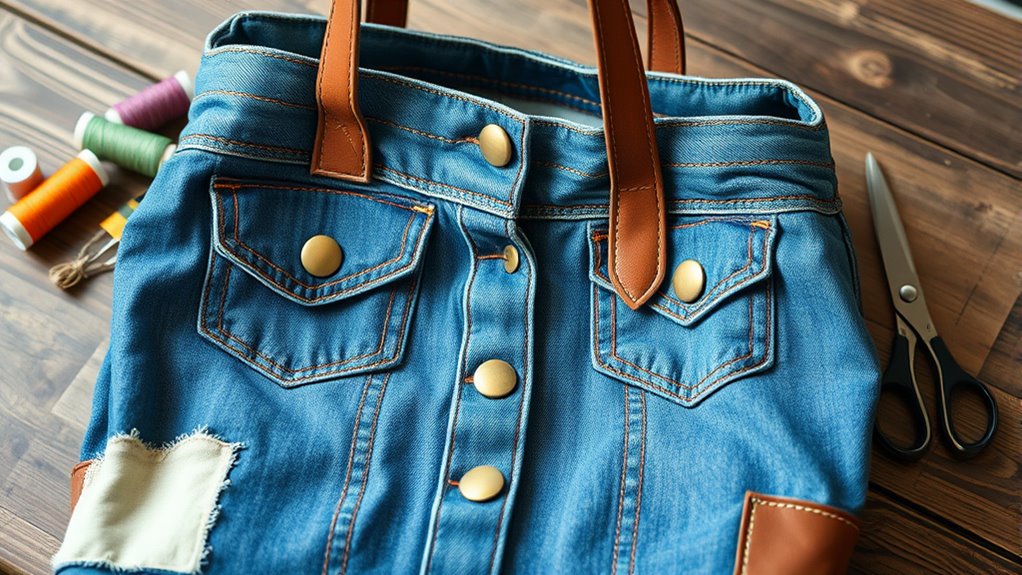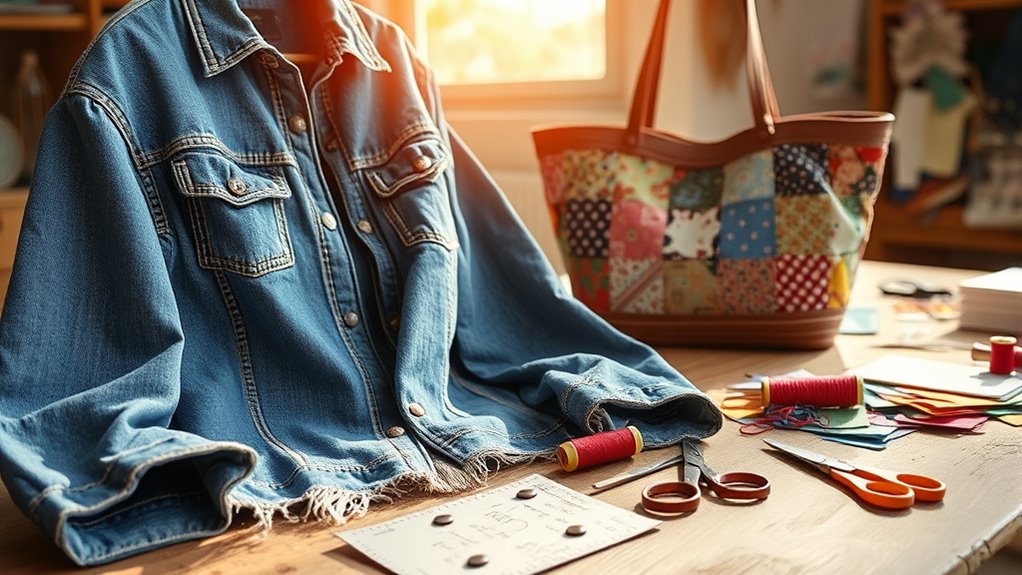To upcycle old clothing into a new bag, start by selecting sturdy fabrics like denim or canvas from your wardrobe. Cut out pieces based on your desired bag style and reinforce stress points with double stitching. Sew the pieces together using simple seams, add straps or handles if needed, and finish raw edges to prevent fraying. Incorporate pockets or decorative details for a personalized touch. Keep exploring to discover more tips for creating unique, durable upcycled bags.
Key Takeaways
- Select sturdy, durable fabrics from old clothing, like denim or thick cotton, suitable for bag construction.
- Measure and cut fabric pieces according to your desired bag size, adding seam allowances.
- Reinforce stress points such as handles and corners with double stitching for added durability.
- Sew seams with straight stitches, finish raw edges with zigzag or overlock, and press for a polished look.
- Add features like pockets or straps using basic techniques, and consider linings or interfacing for structure.

Upcycling old clothing is a creative way to give your wardrobe a fresh new look while reducing waste. Turning an old shirt or pair of jeans into a stylish bag not only saves money but also allows you to craft something uniquely yours. The first step in this process involves careful fabric selection. You want to choose fabrics that are sturdy enough to hold contents without tearing or losing shape. Thick cotton, denim, canvas, or even upholstery fabric work well because they provide durability and structure. If you’re working with a delicate or lightweight fabric, consider adding interfacing or lining to reinforce the bag and give it more stability. When selecting fabric, also think about the color and pattern—pick something that complements your style and the bag’s intended use. Mixing different fabrics can add visual interest, but keep in mind how they’ll work together in *regards to* weight and texture.
Once you’ve chosen your fabric, the real work begins with sewing techniques. You don’t need to be a professional seamstress to create a functional bag; simple, effective sewing techniques will do the trick. Start by measuring and cutting your fabric pieces according to the size and shape you want for your bag. Use straight stitches for most seams, and reinforce stress points like the handles and corners with backstitching or double stitching to ensure durability. If you’re new to sewing, you can use a basic sewing machine or even sew by hand, making sure to keep your stitches even and tight. To create clean edges, finish raw edges with a zigzag stitch or serging if available, preventing fraying over time. Adding features like pockets or straps involves basic techniques, such as topstitching or sewing strips of fabric for handles. Take your time aligning seams and edges; precision here will give your bag a polished look.
Incorporating different sewing techniques, like inserting a lining or adding decorative topstitching, can elevate your upcycled bag. Pay attention to detail—press seams with an iron for neatness and to set stitches. If you want a more structured bag, consider sewing a stiff base or adding interfacing. Remember, the key is to work slowly and carefully, ensuring each stitch is secure. The more thoughtful your fabric selection and sewing techniques, the more durable and stylish your finished bag will be. Upcycling old clothing into a bag is not only environmentally friendly but also a satisfying craft project that lets you express your creativity while breathing new life into items you might have otherwise discarded.
Frequently Asked Questions
What Tools Are Essential for Upcycling Clothes Into Bags?
You’ll need essential tools like sharp scissors for fabric selection and precise cuts, a sewing machine for sturdy seams, and pins or clips to hold pieces in place. Don’t forget a measuring tape for accurate dimensions. Keep your tools well-maintained to guarantee smooth sewing. With these, you can confidently upcycle old clothing into a new bag, transforming fabric into a stylish, functional accessory.
How Do I Choose the Right Clothing Material for a Bag?
Imagine you’re a fashion pioneer in a Victorian novel—choosing fabric material is key. You want sturdy, durable textiles like denim or canvas for strength, but also consider fabric patterns and color coordination to match your style. Opt for fabrics that aren’t too thin or stretchy, ensuring your bag keeps its shape. By selecting the right material, you create a unique, stylish piece that’s both functional and fashionable.
Can I Upcycle Multiple Clothing Items Into One Bag?
Yes, you can definitely upcycle multiple clothing items into one bag. Start by selecting fabrics that complement each other, then sew or glue them together securely. You can add decorative embellishments for a unique look. If you want, try fabric dyeing to unify the colors and make the bag stand out. With some creativity, combining different pieces will give you a stylish, one-of-a-kind bag that reflects your personality.
How Do I Reinforce the Bag’s Durability After Upcycling?
You want your upcycled bag to last? Start with fabric reinforcement by adding interfacing or fusible web to fortify weak spots. Then, focus on seam strengthening—double-stitch or use a zigzag stitch along all seams. Imagine each stitch as a secret weapon, quietly transforming fragile fabric into a sturdy, durable bag. This combination ensures your creation withstands daily wear, ready to hold everything you toss inside without a hitch.
What Safety Precautions Should I Follow During the Process?
You should always wear gloves and work in a well-ventilated area during fabric dyeing to avoid inhaling fumes or skin irritation. When using a sewing machine, keep your fingers clear of the needle and make sure the machine is properly maintained to prevent accidents. Follow all manufacturer instructions, and unplug the machine when not in use. These precautions help keep you safe throughout the upcycling process.
Conclusion
By bravely blending, binding, and brainstorming, you can beautifully transform old clothing into a fabulous new bag. Remember, with a little creativity and confidence, you create not just a unique accessory, but also lessen waste and love your planet a little more. So, don’t delay—dare to design, develop, and dazzle with your DIY masterpiece. Upcycling isn’t just useful; it’s a fun, fulfilling, and fashionable way to give your old clothes a fresh, fabulous future!









